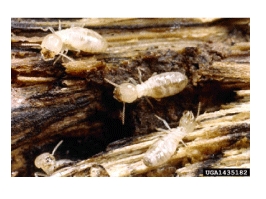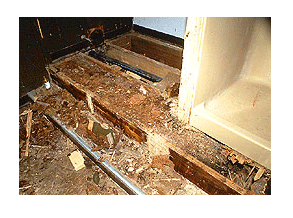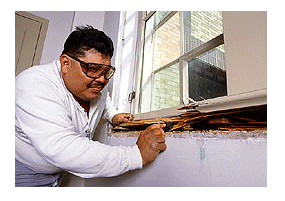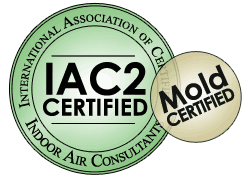Pyramid Home Inspections Call 951-536-1058 for a free price quote!

Pyramid Home Inspections
David Nasser 951-536-1058
Moreno Valley, CA 92553
Termites
Termite Control in the Home
Wood destroying insects and other organisms can cause serious problems in the wood structural components of a house and may go undetected for a long period of time. 
New Construction
All chemical soil treatments, bait systems, and chemical wood treatment must be approved by the Environmental Protection Agency (EPA) and applied in accordance with the EPA label instructions. In some cases it is not feasible for a builder to arrange for soil treatment. In this regard, the International Residential Code (IRC) by the International Code council allows a builder to utilize pressure treated wood as a measure of termite protection. If pressure treated wood is used, however, it must be used in all framing members up to and including the top plate of the first floor level wall. This includes the subfloor and floor joists of the first floor. The use of pressure treated wood in only the sill plate is not acceptable. In such cases, the builder must provide the lender with a letter stating that the house is protected from termites by the use of pressure treated wood. The builder must also provide the home buyer with a one year warranty against termites. The use of post-construction soil treatment where the chemicals are applied only around the perimeter of the foundation is NOT acceptable in new construction.
Appraisers Observations
Appraisers are to observe all areas of the house and other structures/areas within the legal boundaries of the property that have potential for infestation by termites and other wood destroying organisms, including the bottoms of exterior doors and frames, wood siding in contact with the ground and crawl spaces. Mud tunnels running from the ground up the side of the house may indicate termite infestation. Observe the eave and gable vents and wood window sills for indication of the entrance of swarming termites and note excessive dampness or large areas where the vegetation is dead. Evidence of active termite infestation must be noted.
Termites
Subterranean termites are the most damaging insects of wood. Their presence is hard to notice and damage usually is found before the termites are  seen. Prevent infestations because if they occur they will almost always need professional pest control service.
seen. Prevent infestations because if they occur they will almost always need professional pest control service.
Signs of Infestation
Generally, the first sign of infestation is the presence of swarming termites on the window or near indoor light. If they are found inside the house, it almost always means that they have infested. Other signs that may be found are termite wings on window sills or in cobwebs, and shelter tubes which are tunnels constructed by the termites from soil or wood and debris.
Usually, wood damage is not found at first, but when it is found it definitely reveals a termite infestation. Anywhere wood touches soil is a possible entry into a home for termites. Examine wood which sounds dull or hollow when struck by a screwdriver or hammer. Inspect suspected areas with a sharp, pointed tool such as an ice pick to find termite galleries or their damage. 
Control
Control measures include reducing the potential infestation, preventing termite entry and applying chemicals for remedial treatment.
Inspection
Inspect thoroughly to determine if there is an infestation, damage, and/or conditions that could invite a termite attack or the need fo remedial control measures. The tools and equipment needed for an inspection include a flashlight, ice pick or sharp-pointed screwdriver, ladder and protective clothing.
Outdoors
Check the foundation of the house, garage and other buildings for shelter tubes coming from the soil. Look closely around porches, connecting patios, sidewalks, areas near kitchens or bathrooms and hard-to-see places. Check window and door frames and where utility services enter the house for termite infestation or wood decay. Also look behind shrubbery or plants near walls. Pay special attention to areas where earth and wood meet such as fences, stair carriages or trellises. Open and check any exterior electrical meter or fuse box set into the wall, a common point of infestation.
Indoors
Carefully check all doors, window facings, baseboards and hardwood flooring. Discoloration or stains on walls or ceilings may mean that water is leaking and can decay wood and aid termite infestation. It is very important to inspect where plumbing or utility pipes enter the foundation or flooring. Also examine the attic for shelter tubes, water leakage, and wood damage.
Prevention
Many termite problems can be prevented. The most important thing to do is deny termites access to food (wood), moisture and shelter.Follow the sugestions below.
- have at least a 2-inch clearance between the house and planter boxes or soil-filled porches
- elimiate all wood-to-soil contacts such as trellises, fence posts, stair casings and doorfacings (they can be put on masonary blocks or on treated wood)
- separate shrubbery from the house to help make it easier to inspect the foundation line
- use wolmanized wood (pressure-treated wood) so that rain will not rot it
- seal openings through the foundation
- remove wood scraps or stumps from around foundations
- have at least 12"-18" clearance between floor beams and the soil underneath
Chemical Treatment
Termite treatment often requires specialized equipment. Therefore, it is recommended that you always use the services of a pest control operator because he is familiar with construction principles and practices, has the necessary equipment and knows about subterranean termites.
Exterminating Termites
If you think you have a termite infestation in your house, you need to call a structural pest control company to conduct a professional inspection. To find a company, ask friends or coworkers for recommendations, or check the yellow pages. If the inspection finds evidence of drywood termites, you have several options, depending on the degree of infestation. Fumigation and heating of the entire house are the only options that ensure eradication in the entire structure. If the infestation is contained in a small area, local or spot control may be effective. However, hidden infestations in other part of the structure will not be eredicated.
Total (Whole-House) Eradication
For the heat method, pets, plants, and other items that might be damaged by high temperatures must be removed. The house is then covered with tarps, and hot air is blown into the tarp until the inside temperature reaches 140 to 150F and the temperature of the structural timbers reaches 120F. The time to complete this procedure varies greatly from one structure to another, depending on factors such as the building's construction and the weather conditions. The procedure may not be practical for structures that cannot be heated evenly.
Local or Spot Control
Local or spot control methods include the use of pesticides, electric current, extreme cold, localized heat, microwave energy, or any combination of these methods. Local or spot control also includes the removal and replacement of infested structural timber. These methods are intended to remove or kill termites only within the specific targeted area, leaving open the possibility of other undetected infestations within the structure. These treatments are NOT designed for whole-house eradication. Any pest control company that claims whole-house results with local or spot control methods is guilty of false advertising and should be reported.
Local or spot treatment with pesticides involves drilling and injecting pesticides into infested timbers, as well as the topical application of toxic  chemicals. The electric current method involves delivering electric energy to targeted infestations. For the extreme cold method, liquid nitrogen is pumped into wall voids adjacent to suspected infestation sites, reducing the area to -20F. The localized heat method involves heating infested structural timbers to 120F. The microwave method kills termites by directing microwaves into termite-infested wood.
chemicals. The electric current method involves delivering electric energy to targeted infestations. For the extreme cold method, liquid nitrogen is pumped into wall voids adjacent to suspected infestation sites, reducing the area to -20F. The localized heat method involves heating infested structural timbers to 120F. The microwave method kills termites by directing microwaves into termite-infested wood.
If you see the following signs in your house, you might have termites:
sawdust-like droppings
dirt or mud-like tubes or trails on the structure
damaged wood members (like window sills)
swarming winged insects within the structure, especially in the spring or fall
Here's what our clients say about us
"David's work is the best! Always gets the job done right away!! Would definitely recommend him to all my clients"
Sunny Wang - Etopbroker
My name is David Nasser, and I know Riverside homes. Give me a call at 951-536-1058 to discuss your home inspection needs.
Need a website for your business?




